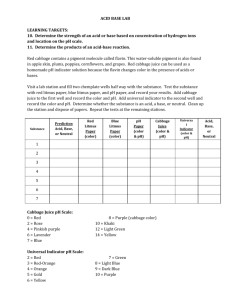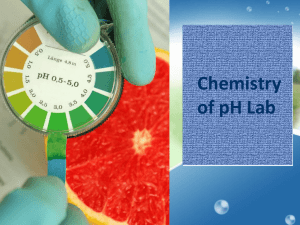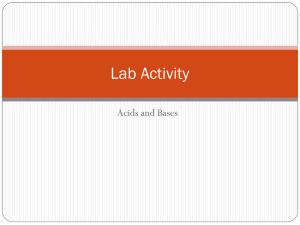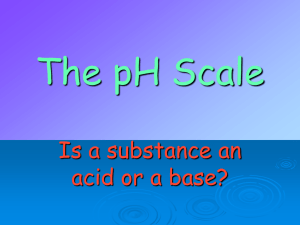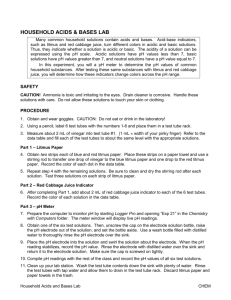Testing pH of Substances using LITMUS paper, pH
advertisement
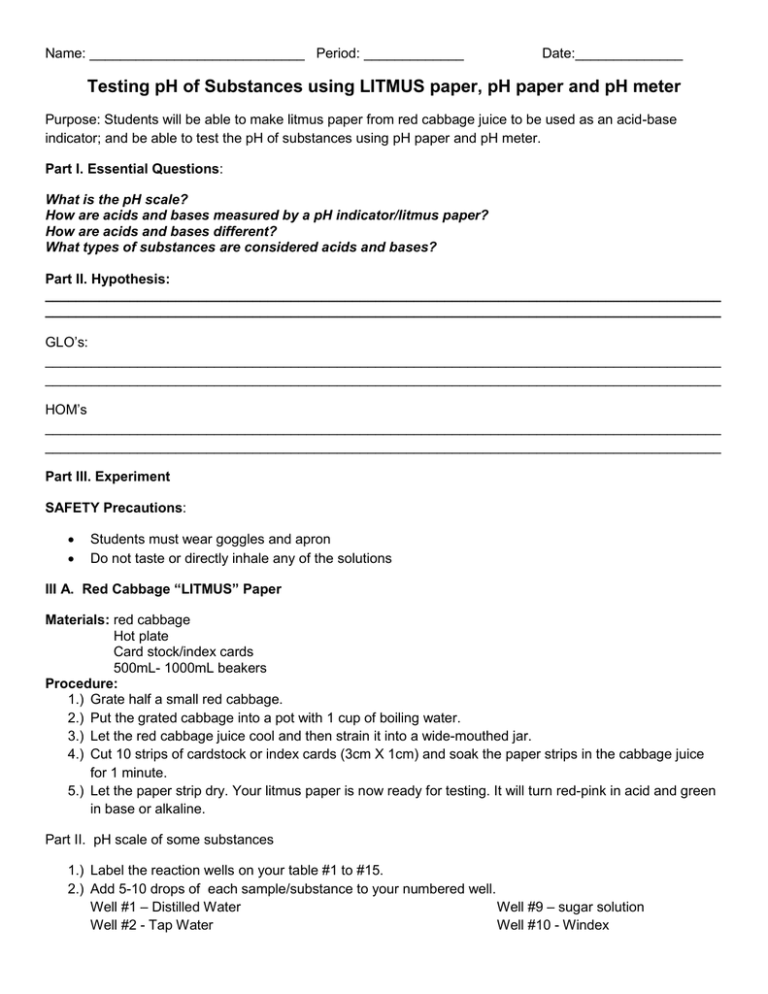
Name: ____________________________ Period: _____________ Date:______________ Testing pH of Substances using LITMUS paper, pH paper and pH meter Purpose: Students will be able to make litmus paper from red cabbage juice to be used as an acid-base indicator; and be able to test the pH of substances using pH paper and pH meter. Part I. Essential Questions: What is the pH scale? How are acids and bases measured by a pH indicator/litmus paper? How are acids and bases different? What types of substances are considered acids and bases? Part II. Hypothesis: ________________________________________________________________________________________ ________________________________________________________________________________________ GLO’s: ________________________________________________________________________________________ ________________________________________________________________________________________ HOM’s ________________________________________________________________________________________ ________________________________________________________________________________________ Part III. Experiment SAFETY Precautions: Students must wear goggles and apron Do not taste or directly inhale any of the solutions III A. Red Cabbage “LITMUS” Paper Materials: red cabbage Hot plate Card stock/index cards 500mL- 1000mL beakers Procedure: 1.) Grate half a small red cabbage. 2.) Put the grated cabbage into a pot with 1 cup of boiling water. 3.) Let the red cabbage juice cool and then strain it into a wide-mouthed jar. 4.) Cut 10 strips of cardstock or index cards (3cm X 1cm) and soak the paper strips in the cabbage juice for 1 minute. 5.) Let the paper strip dry. Your litmus paper is now ready for testing. It will turn red-pink in acid and green in base or alkaline. Part II. pH scale of some substances 1.) Label the reaction wells on your table #1 to #15. 2.) Add 5-10 drops of each sample/substance to your numbered well. Well #1 – Distilled Water Well #9 – sugar solution Well #2 - Tap Water Well #10 - Windex Well #3 – Hydrochloric acid (BE CAREFUL) Well # 11 - Soda Well #4 – Sodium hydroxide Well # 12 - Tea Well #5 – juice Well #13 - Coffee Well #6 – baking soda solution Well # 14 - Zonrox Well #7 – soap solution Well # 15 - Lysol Well #8 – milk 3.) Dip a “litmus paper” to each tube containing the sample/ substances. Observe the color change of the litmus paper and record it on the data table below. 4.) Dip a pH paper to each tube containing sample/ substances. Observe the color change and compare it to the color chart provided. The color chart has a corresponding number which is the pH of the substance. The pH scale of pH paper ranges from 1-14. Record the corresponding pH number of your substance on the data table below. Data Table. The pH of different samples/substances. Sample #1 – Distilled Water #2 - Tap Water #3 – Hydrochloric acid (HCl) #4 – Sodium hydroxide #5 – juice #6 – baking soda solution #7 – soap solution #8 – milk #9 – lemon #10 – Windex # 11 – Soda # 12 – Tea #13 – Coffee # 14 – Zonrox # 15 – Lysol Prediction: Is it an acid or base? Color change of Litmus Paper Is it and acid or base? pH scale using pH paper pH using pH meter Part IV. Analysis and Discussion: Please answer in COMPLETE sentences to receive FULL credit. 1. What does the pH scale indicate? 2. What is an acid? Where are they found on the pH scale? 3. What is a base? Where are they found on the pH scale? 4. Which substances were acid? Base? Neutral? 5. Were any of your results surprising? Why or why not? 6. Write 5 facts you learned about acids and bases. Part V. Conclusion and Reflection: (Write what you learned about this lab activity. Did the hypothesis teach you anything? Were the results what you expected? Why or why not? Is there anything you want to change or add to this lab? Reflection: (Write at least 3 sentences about this lab activity- It can be based on what you learned or any question regarding our lesson on acids and bases)


